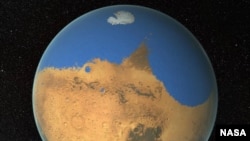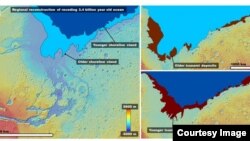Does anyone remember the movie "Deep Impact" about a doomsday asteroid heading toward Earth?
Spoiler alert: Humanity survives, but not without severe damage due to a fairly large chunk of rock that hits the Atlantic Ocean.
The resulting tsunami sends a giant wave all the way to the foot of the Appalachian mountains.
Today, scientists from Cornell University published research suggesting events like this happened on Mars billions of years ago.
The red, wet planet
Yes, Mars!
The Martian oceans are long gone now, but last year, NASA published new research and illustrations of its once giant body of water.
Liquid water NASA says likely covered nearly half of the red planet's Northern Hemisphere.
According to scientists from Cornell University and the Planetary Science Institute, that ocean was hit by at least two huge meteors that triggered giant tsunami's on the planet's surface.
VOA reported this week on new evidence there were a lot of big rocks floating around the inner solar system 3 billion years ago.
Alberto Fairen, a Cornell visiting scientist in astronomy and principal investigator at the Center of Astrobiology, Madrid, told VOA impacts like this were fairly common.
"...big rocks were floating around the inner solar system at that time,' he told VOA. "And we are finding plenty of evidence of their collisions with planets and moons everywhere."
The first Martian impact happened about 3.4 billion years ago. "This wave was composed of liquid water" Fairen says. "It formed widespread backwash channels to carry the water back to the ocean."
Fairen and lead author Alexis Rodriguez of the Planetary Science Institute and 12 others, published their work in Scientific Reports.
A different asteroid hits a different Mars
One of the really exciting elements of the new research is the clues it gives us to the continuing search for life on Mars.
"Water was abundant on Mars," Fairen told VOA, "and therefore the planet was a perfect place for life development ..."
But when the second asteroid hit, millions of years later the oceans had shrunk, and according to Fairen were at least partially frozen.
By that time Mars had entered an era called the Hesperian when Mars, Fairen told VOA "transitioned from a "cold and wet" planet at the beginning to the "very cold and hyperarid" world it is today.
That asteroid impact sent the now icy water, in the form of frozen lobes inland where they stayed, and never flowed back to the diminishing oceans.
Fairen notes that the shape of the icy lobes suggests the water was salty, and that increases the chances the water once held life.
"Cold, salty waters may offer a refuge for life in extreme environments, as the salts could help keep the water liquid." Fairen said. "... If life existed on Mars, these icy tsunami lobes are very good candidates to search for biosignatures,"
Fairen told VOA the team used information they pulled from Mars orbiters' thermal, infrared and high resolution pictures.
He said technology has advanced to the point where he can see "features on the surface of Mars as small as a few meters big."










